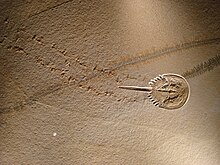Kouphichnium: Difference between revisions
m →top: switch to .com for Google Books; same content, but more trustworthy top-level domain, replaced: &hl=es& → &hl=en&, https://books.google.es/ → https://books.google.com/ |
No edit summary |
||
| (6 intermediate revisions by 6 users not shown) | |||
| Line 1: | Line 1: | ||
{{Short description|Trace fossil}} |
|||
{{italic title}} |
|||
{{Ichnobox |
{{Ichnobox |
||
| name = ''Kouphichnium'' |
|||
| fossil_range = {{fossil range|318.1|66.043}} |
| fossil_range = {{fossil range|318.1|66.043}} |
||
| taxon = Kouphichnium |
| taxon = Kouphichnium |
||
| Line 9: | Line 8: | ||
}} |
}} |
||
'''''Kouphichnium''''' is an [[ichnogenus]] that has been attributed to [[limulid]]s (horseshoe crabs). ''Kouphichnium'' fossils resemble the [[footprint]]s of birds, sometimes in conjunction with a medial line,<ref>{{cite web|url=https://web.archive.org/web/20171015192216/http://envs.emory.edu/faculty/MARTIN/ichnology/Kouphichnium.htm|title=''Kouphichnium'' isp.|first=Anthony J.|last=Martin}}</ref> and were initially thought to be bird or [[pterosaur]] tracks. The footprints are now believed to be the imprints of specialized limulid [[appendage]]s, called pushers, terminating in four plates, used to push against the sediment. The medial line is left by the animal's [[telson]]. This ichnogenus is registered in the [[Carboniferous]] to the [[Cretaceous]], in marine marginal environments in [[Tennessee]], the [[United States]] and in [[Poland]], as well as non-marine environments of [[Argentina]] and [[England]], among others.<ref>Aceñolaza, F. G., & Buatois, L. A. (1991). Trazas fósiles del Paleozoico superior continental argentino. ''[https://books.google.com/books?id=g6w033j_gs8C |
'''''Kouphichnium''''' is an [[ichnogenus]] that has been attributed to [[limulid]]s (horseshoe crabs). ''Kouphichnium'' fossils resemble the [[footprint]]s of birds, sometimes in conjunction with a medial line,<ref>{{cite web|url=http://envs.emory.edu/faculty/MARTIN/ichnology/Kouphichnium.htm|archive-url=https://web.archive.org/web/20171015192216/http://envs.emory.edu/faculty/MARTIN/ichnology/Kouphichnium.htm|url-status=dead|archive-date=2017-10-15|title=''Kouphichnium'' isp.|first=Anthony J.|last=Martin}}</ref> and were initially thought to be bird or [[pterosaur]] tracks. The footprints are now believed to be the imprints of specialized limulid [[appendage]]s, called pushers, terminating in four plates, used to push against the sediment. The medial line is left by the animal's [[telson]]. This ichnogenus is registered in the [[Carboniferous]] to the [[Cretaceous]], in marine marginal environments in [[Tennessee]], the [[United States]] and in [[Poland]], as well as non-marine environments of [[Argentina]] and [[England]], among others.<ref>Aceñolaza, F. G., & Buatois, L. A. (1991). Trazas fósiles del Paleozoico superior continental argentino. ''[https://books.google.com/books?id=g6w033j_gs8C Ameghiniana]'', 28, 89-108. {{in lang|es}}</ref> The genus contains five species, ''K. arizonae'', ''K. cordifomnis'', ''K. lithographicum'', ''K. minusculum'' and ''K. walchi''. |
||
==See also== |
==See also== |
||
* [[List of xiphosuran genera]] |
* [[List of xiphosuran genera]] |
||
* [[Timeline of pterosaur research]] |
* [[Timeline of pterosaur research]] |
||
* [[Ichnology]] |
|||
* [[Trace fossil]] |
* [[Trace fossil]] |
||
* [[Mortichnia]] |
|||
==References== |
==References== |
||
{{reflist}} |
{{reflist}} |
||
{{Taxonbar|from1=Q6434676}} |
|||
[[Category:Arthropod trace fossils]] |
[[Category:Arthropod trace fossils]] |
||
Latest revision as of 09:52, 14 June 2023
| Kouphichnium Temporal range:
| |
|---|---|

| |
| Mesolimulus walchi with trackway | |
| Trace fossil classification | |
| Domain: | Eukaryota |
| Kingdom: | Animalia |
| Phylum: | Arthropoda |
| Subphylum: | Chelicerata |
| Order: | Xiphosura |
| Ichnogenus: | †Kouphichnium Nopcsa, 1923 |
Kouphichnium is an ichnogenus that has been attributed to limulids (horseshoe crabs). Kouphichnium fossils resemble the footprints of birds, sometimes in conjunction with a medial line,[1] and were initially thought to be bird or pterosaur tracks. The footprints are now believed to be the imprints of specialized limulid appendages, called pushers, terminating in four plates, used to push against the sediment. The medial line is left by the animal's telson. This ichnogenus is registered in the Carboniferous to the Cretaceous, in marine marginal environments in Tennessee, the United States and in Poland, as well as non-marine environments of Argentina and England, among others.[2] The genus contains five species, K. arizonae, K. cordifomnis, K. lithographicum, K. minusculum and K. walchi.
See also[edit]
References[edit]
- ^ Martin, Anthony J. "Kouphichnium isp". Archived from the original on 2017-10-15.
- ^ Aceñolaza, F. G., & Buatois, L. A. (1991). Trazas fósiles del Paleozoico superior continental argentino. Ameghiniana, 28, 89-108. (in Spanish)
